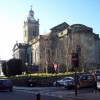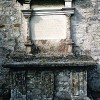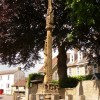On April 19th 1848 Emmanel and Charlotte Mabey took their second child to St. Mary’s Church at Beaminster to be baptised; the child was named William, after his grandfather, and he was destined to enjoy a long and successful life. In his later years he was a respected member of the Master Builders section of the Bournemouth Chamber of Trade; he built the Solent Cliffs Hotel and the South Western Hotel in Bournemouth and produced most of the furniture for the Grosvenor Hotel in London as well as making carts for London’s Covent Garden Market.
He passed away in 1931 but a few months before he died he recorded his memories of Sutton, the village where he lived as a teenager. He describes a small village hidden away under the Downs with many old houses and an Inn called ‘Springbottom Inn’. Mabey also reminds us that in the time of George III a main road leading to the Downs passed through Sutton and that at the top of the road there was gate right across it; nearby there were some large trees about which it was said people had been hung and quartered there. He remembered a very old lady living in an ancient house who told him she could remember as a child opening the gate to let the soldiers through.
He also recorded his memories of the murder, in 1862, of Dr. Puckett, who was the Union doctor from Upwey treating a man named Cox for a brain disease, apparently with little success. Cox lived at the bottom of Sutton Knapp. William Mabey recalled “..one haymaking time when we were busy making hay in the field near Chalbury Hill (through which there was a public footpath to Broadwey) Dr. Puckett happened to pass and he told my father he was going to see Cox who was lying ill at Sutton. Dad strongly advised the doctor not to go alone as this man was a dangerous lunatic, but the doctor said he would be alright.”
“Well, about an hour later word came through that the doctor had been murdered and that the man had gone in the direction of Osmington, so we all took our prongs and hurried off to try to catch him. We eventually ran him to earth in the stable of the Plough Inn. My father was the first to arrive and found the door barred, so he called out to Cox to open it. Cox said “who is it?” and my father answered “Mabey.” My father then told him to hurry up and come out and that he would help him, so believing this he came out and was soon made safe.” It seems that Cox had heard that Dr Puckett was recommending he be sent to the asylum at Forsten.
This was a horrific murder. It seems the doctor quickly realised he was in danger and made for the door but Cox jumped up and broke off one of the bed posts. Meanwhile, the doctor on the other side of the door held it shut before running off. Cox, realising he could get out of the cottage chased after the doctor throwing a brickbat at him which hit the doctor on the head. The doctor fell, Cox seized a saw and sawed off the doctor’s foot before sawing off his right hand and head. Cox then went back to the cottage got his clothes and ran off to the Plough Inn at Osmington.
Cox was tried for murder at Dorchester, certified insane and sent to an asylum where he died many years later. William Mabey said: “the murder of Dr. Puckett was a great shock to all the village. I saw the body before it was removed.”
In 1863, a year after the doctor’s murder, William was 15 years of age. He witnessed the public hanging at Dorchester of two men, Preedy and Fooks. (See our article The Prisoner a Padre Befriended, published February 9th 2010 in the Real Lives category.) William says of the event: “About this time two men were hung in Dorchester, being the last to be hanged in public. I went from Sutton to see this, staying at my cousin’s house in Glyde Path Hill where from one of the bedrooms we could see everything quite clearly. I waited the hour and then they were cut down and laid in their coffins. Thousands of people came from all parts to witness the hanging and the meadows near the river were crowded. People even climbing trees so that they would have a good view, It was an awful sight, I should not like to see anything of the sort now.”
William also reported that some enterprising builders had erected a grandstand and sold seats for 2/6d; apparently the stand collapsed under the weight of spectators.
Born at Waterhouse, Bettiscombe, William moved with his parents and siblings to Kingcombe in the parish of Toller Porcorum, from there to Preston with Sutton Poyntz before marrying and settling with his young bride in Melcombe Regis and Weymouth.
Emmanuel Mabey came from the parish of Mapperton and married Charlotte at St. Mary’s Church, Beaminster on July 21st 1845. The couple lived at Waterhouse, Bettiscombe, but by 1861 the family was living at Kingcombe in the parish of Toller Porcorum; the census reveals the family had grown and William had four brothers and two sisters. The youngest child is just six months old and has been named George; further research reveals that Emmanuel and Charlotte’s first born child, also named George, had died early in 1860.
His mother’s maiden name was Elliott and her father claimed relationship with Charlotte Elliott, the poetess. His mother of necessity had a very strong personality, for she had to cope with her husband’s frequent bouts of depression.



